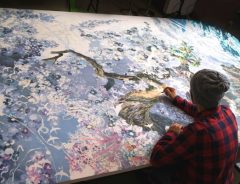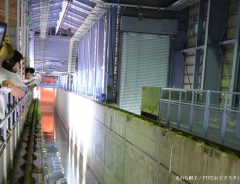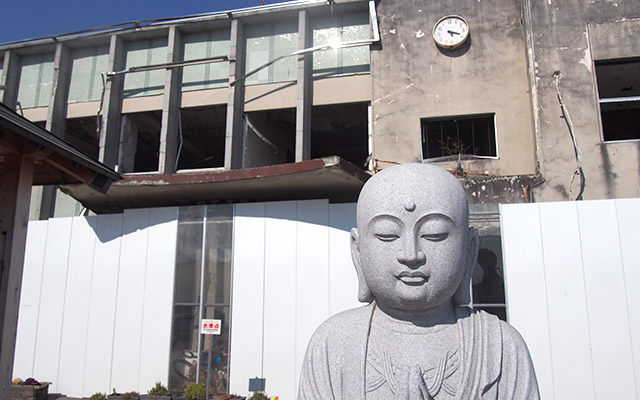- Tags:
- Disaster / Earthquake / Tohoku
Related Article
-

Coca-Cola celebrates 3 festivals from northern Japan in one gorgeous design sold exclusively in Tohoku
-

7 Years After Great East Japan Earthquake, Fukushima Locals Band Together To Revitalize The Area With Charming Souvenirs[PR]
-

Japanese Artist Reveals Magnificent Pen & Ink Drawing 3.5 Years In The Making
-

[VIDEO] Flood Wall Collapses In Ibaraki, Japan Causing A Havoc
-

[3.11 Earthquake: Rebuilding] OshimaーTen Years of Friendship, Ten Years of Gratitude
-

After Japan’s 1m Tsunami Warning, Simulation Videos Circulate to Give Reality Check to Social Media Doubters



It was 5 years ago on March 11, 2011, when a major earthquake and Tsunami had hit the Tohoku region and Japan.
The footage of the 'wall' of tsunami washing away people and its township had left a huge scar on people in Japan.
While we have seen many footage as well as various information from the Internet and other news outlets, it's a different matter to actually seeing the site first hand and listening to people who had experienced the horror.
So we decided to head to Iwate prefecture to do just that.
Voice of the survivors
First, we visited the township of Kamaishi. The coastline around this area is known to be one of the worst affected in the earthquake and tsunami.
However, there was also an instance called "The miracle of Kamaishi", where 3,000 elementary and junior high school students evacuated the school to survive.
How did almost all students survive?
We went to "Nonbee Yokocho" near Kamaishi station, where bars and eateries are housed inside prefabricated temporary buildings. And we've talked to Kohei Yamazaki, who runs an Izakaya restaurant called Umifune.
It has been 5 years, yet the moment Yamazaki spoke, it felt as if that moment had reappeared in our eyes.
That was terrifying indeed. The shop that I had was totally devastated by the tsunami; all that was left of it was the metal frame.
He was kind enough to take us to Unosumai and Otsuchi, where the tsunami had hit.
Scars of the disaster
First, Yamazaki took us to where Kamaishi Higashi Junior High School and Unosumai Elementary School buildings were.
The two schools are well known, because students had decided to evacuate to a higher ground than the initially-specified evacuation point.
When you look at the site, it is hard to believe that until 5 years ago, children were playing and studying.
A stadium to host the 2019 Rugby World Cup is being built on the site; there were many trucks driving around the area.
A lot of people are against building this stadium, because there are still many who are living in temporary shelters.
While building a stadium would lead to better transport infrastructure, but some believe that providing care to locals should be prioritized.
Looking at Usunomai river, Yamazaki spoke of the danger of the river during a tsunami.
Rivers are really scary when tsunami comes. They come upstream using the river as the path, taking down all the nearby residence.
In order to prevent tsunami from entering the river, construction was underway for a water gate.
Expieriencing the evacuation route
We then decided to take a walk on a path that children used to evacuate.
First stop was the care home for the elderly; it was specified as the evacuation point.
It is located approximately 900 m from the school. While there is some distance from school, the path is flat. To stay away from tsunami, you have to climb.
We knew that because we've seen how dangerous tsunami is. But children who were evacuating on March 11, 2011, they would've had no idea about this.
Beside the care home is a steep hill by the car park.
Children and nearby residents thought waiting beneath this cliff-like spot is dangerous. So they've decided to move further away from the ocean.
As we walked away from the ocean, we finally felt that we were climbing to a higher place.
Now they were 1.5 kilometers from the elementary school, and more importantly, over 20 meters above sea level.
1. School 2. Care home 3. Final evacuation spot
My grandson lost both of his shoes while he was running away, but he had to keep going before tsunami catches him.
Although it was a miraculous event, we have to take on the lessons learned from it, so that people are prepared in the event of another disaster.
Survivor who was washed out to the ocean, and returned
Yamazaki then took us to the ocean by the Otsuchi harbor.
You were able to see sand dunes from here, it was nice. But now they are inside the ocean.
Yamazaki had affinity with this place: he used to take his grandson here.
The damage by the seaside was severe, with tsunami reaching to the third floor of this hotel.
The village by the ocean was washed up, taking away many people's lives.
However, there was a person who was washed away out into the sea but miraculously returned back to the same beach.
He was taken away to the shore with the tsunami, but he grabbed onto whatever he can grab hold of. He kept on lurching onto various things so that he doesn't sink.
Then, the current brought him back to the beach. He was so lucky.
100 fire trucks from 1,000 km south
Yamazaki spotted someone driving in the other direction and told us this.
He used to be a fireman. He went and closed the water gates before tsunami came, and he ran away to a higher ground before tsunami came.
But he couldn't let his family know about the tsunami; five of his family were all dead because of the tsunami.
There were, however, also stories that shows the good side of humanity.
After the tsunami, what struck the affected area was fire. Burning many buildings and mountains, the fire lasted for about a week.
What helped extinguish this fire was the Osaka fire department. Osaka is located over 1,000 km from Kamaishi.
Over 100 fire trucks came from Osaka. Without them, the fire wouldn't have been put out.
Policemen from Hyogo prefecture also came to prevent theft and other opportunist crimes.
"Tsunagi" and "Kizuna" - meaning bond or tie - was a key slogan after the disaster. But this story really was a great example of how important these human bonds were during such an atrocity.
The danger of the 'invisible' tsunami
We then went to Otsuchi town hall. Many staff here were taken by the tsunami, because they did not realize that tsunami was on its way.
People who evacuated in the town hall car park also did not realize that tsunami was coming, because buildings surrounding the car park prevented any view of the ocean.
In the end, tsunami had hit up to the third floor of the town hall.
The broken outer wall of the town hall is the evidence of the damage tsunami can cause.
As at the time of writing this article, people are undecided as to whether they should keep the town hall as a memorial.
While it is an important asset to show the danger of tsunami, many residents do not want to see it.
Even Yamazaki says that seeing these sites brings back painful memory of that horrendous day.
Yes it's hard to look at these buildings. It wasn't so hard to get to the mountains, but I think many of us just didn't think like that.
Town disappeared
We've drove up the mountain, where we can overlook the entire Otsuchi township.
Many people drove to evacuate to this mountain. And it caused a traffic jam.
Once they had reached the mountain, they should have stayed, but many went down the mountain when they saw the first tsunami wave pull away.
Because it was really cold that day, people went back home to pick up a blanket, or other things for their kids and whatnot.
But whoever went down the mountain never returned.
People always said to never go back. But even after seeing that horrendous tsunami, people still didn't take simple precautions.
Tsunami doesn't end with one wave. People must remember that.
In addition, people who could not get up the mountain by car, they parked the car at the bottom of the mountain.
Because of the cold weather, many stayed in the car to keep warm.
Since they're in the car, no matter how much people from above says "tsunami's coming", it was no use.
A few simple precautions would have changed the situation so greatly. Survivors must now pass on the message so that people don't make similar mistakes again.
Perhaps Yamazaki had this intent in mind when he kindly took us around to these affected areas.
5 years on, Otsuchi is still mostly lifeless.
A construction worker recently told Yamazaki about the time it may take to recover.
It's nowhere near ready; it would take at least 5 more years.
5 years on, Otsuchi and many other places are still desolate, and wounds in survivors' hearts are still deep.
What we can take away from this is that many people could have survived if they took appropriate measures in an event of disaster.
If we don't do so, all the lives lost in the disaster would have done so in vain.